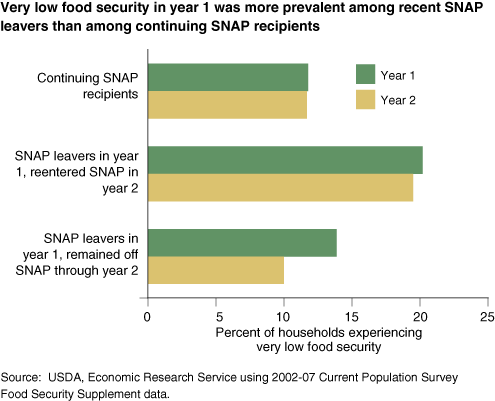Some Households No Longer Eligible for SNAP Have Unmet Food Needs
- by Alisha Coleman-Jensen and Mark Nord
- 9/1/2011
SNAP (the Supplemental Nutrition Assistance Program, formerly the Food Stamp Program) provides resources to help eligible low-income families obtain nutritious food. Very low food security--characterized by disrupted eating patterns and reduced intake--is more prevalent among households that recently left SNAP than among households still receiving assistance.
A recent study by ERS researchers examined the economic conditions of households that had recently left SNAP to find out why households with unmet food needs leave the program. Data from households interviewed in 2 consecutive years of the 2002-07 Current Population Survey Food Security Supplements provided a longer term view of the food security situations of households after they left SNAP. Households that participated in SNAP sometime in the first year of a 2-year period, but not in the final 30 days of that year, were classified as 'SNAP leavers.'
Two distinct groups of SNAP leavers were identified. The first group, about one-third of those that left in the first year, returned to SNAP in the second year. Shortly after leaving SNAP, these households had a higher prevalence of very low food security (20.2 percent) than continuing participants (11.8 percent). Even after returning to SNAP in the second year, they continued to have higher rates of very low food security (19.5 percent) than those that never left.
The second group left SNAP in the first year and remained off the program throughout the second year. These households also had a higher prevalence of very low food security (13.9 percent) after recently leaving SNAP than those that remained on SNAP. However, by the end of the second year, very low food security among households that remained off SNAP throughout the second year declined (10.0 percent) and was somewhat less prevalent than among continuing recipients (11.7 percent).
ERS researchers then investigated why households that were not fully food secure left SNAP and found that those that left had better employment and higher incomes than households that remained on SNAP. Most of the households that left SNAP apparently did so because they were no longer eligible for SNAP or were eligible for only relatively small benefits based on their income levels. Even though recent SNAP leavers were generally better off economically than continuing recipients, recent leavers were still more likely than continuing recipients to face very low food security in the first year after leaving SNAP.
The findings suggest that the period of transitioning off the program can be a financially challenging time for some households despite their improved economic circumstances. More research is needed to understand what happens to households as they transition off the program.
This article is drawn from:
- 'Food Insecurity After Leaving SNAP'. (2010). Journal of Hunger & Environmental Nutrition. Vol. 5, No. 4, pp. 434-453..


